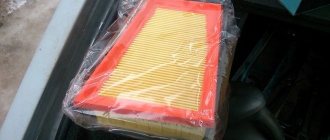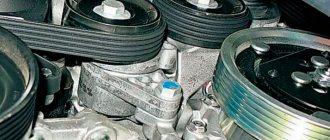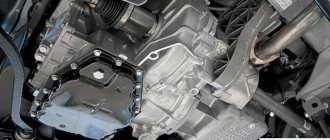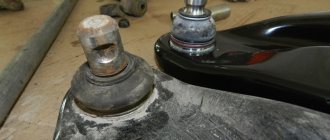Most Lada Largus cars are equipped with five-speed manual transmissions. These can be models JH3 and JR5, depending on the engine installed in the car. The five-speed manual transmission of the Lada Largus ensures clear and smooth engagement of the selected gear, transmitting torque from the engine through the transmission to the drive wheels. When designing the Largus model range, an automatic transmission was not provided. However, at the insistence of the project director, in 2012 a modernized Lada Largus model with an automatic transmission was released. The cars were offered as a station wagon.
Gear ratios of Lada Largus gearboxes
Depending on the Largus configuration, the standard 5th gear ratios may be different. Comparisons of different modifications in the table:
| Equipment | Station wagon 5 seats K7M (1.6l, 8kl), JH3 540 | Station wagon 7 seats K7M (1.6l, 8kl), JR5 551 | Station wagon 5 and 7 seats K4M (1.6l, 16cl), JR5 549 | Van JR5 517 |
| 1st gear | 3,727 | |||
| 2nd gear | 2,048 | |||
| 3rd gear | 1,393 | 1,321 | 1,393 | 1,321 |
| 4th gear | 1,029 | 0,971 | 1,097 | 0,971 |
| 5th gear | 0,820 | 0,795 | 0,892 | 0,738 |
| Reverse | 3,545 | |||
| Main couple | 4,214 | 4,5 | 4,214 | 4,928 |
Which 5th gear gear is better to choose?
The table shows the car speed values at different gear ratios of Largus 5th gear, as well as the article number of the driven and driving gears:
| Gear ratio 5th gear | Catalog number 1 | Catalog number 2 | Speed at 3000 rpm | Main couple |
| 0,892 | 8200611295 | 8200608035 | 93,6 | 4,214 |
| 87,6 | 4,5 | |||
| 80,0 | 4,928 | |||
| 0,820 | 8200611299 | 8200607980 | 101,8 | 4,214 |
| 95,3 | 4,5 | |||
| 87,0 | 4,928 | |||
| 0,795 | 8200611297 | 8200607978 | 105,0 | 4,214 |
| 98,3 | 4,5 | |||
| 89,8 | 4,928 | |||
| 0,756 | 8200611301 | 8200607981 | 110,4 | 4,214 |
| 103,4 | 4,5 | |||
| 94,4 | 4,928 | |||
| 0,738 | 8200611303 | 8200607983 | 113,1 | 4,214 |
| 105,9 | 4,5 | |||
| 96,7 | 4,928 |
Technical characteristics of Renault Logan
| Version | 1.4 | 1.6 | 1.6 16V | 1.6 16V | 1.5DCI | 1.5DCI | 1.5DCI |
| Engine | petrol | petrol | petrol | petrol | turbodies | turbodies | turbodies |
| Volume | 1390 cm3 | 1598 cm3 | 1598 cm3 | 1598 cm3 | 1461 cm3 | 1461 cm3 | 1461 cm3 |
| Cylinder/Valve Arrangement | R4/8 | R4/8 | R4/16 | R4/16 | R4/8 | R4/8 | R4/8 |
| Maximum power | 75 hp | 84 hp | 102 hp | 103 hp | 65 hp | 68 hp | 86 hp |
| Maximum torque | 112 Nm | 128 Nm | 148 Nm | 148 Nm | 160 Nm | 160 Nm | 200 Nm |
| Dynamics | |||||||
| Max. speed | 162 km/h | 175 km/h | 183 km/h | 190 km/h | 155 km/h | 158 km/h | 167 km/h |
| Acceleration 0-100 km/h | 13.0 sec | 11.5 sec | 10.2 sec | 9.5 sec | 15.5 sec | 15.2 sec | 13.0 sec |
| Average fuel consumption in l/100 km | 6.9 | 7.3 | 7.1 | 7.0 | 4.8 | 4.7 | 4.6 |
Replacing Largus 5th gear gear
The design of the Largus transmission allows you to change the 5th gear gears without disassembling the entire gearbox or even removing it from the car. You will need a gear puller, a hair dryer and two screwdrivers. If you have the necessary tools, the process takes no more than 2-3 hours. Video instructions:
When replacing gears with their own hands, car enthusiasts most often encounter difficulties when dismantling a small gear. Removing it without a special puller is not so easy, because... it sits on the shaft using a thread locker. In this situation, a hair dryer can be useful; after heating, the part will easily slide off. Don't forget to fill in new transmission oil.
Largus gearbox oil: partial and complete replacement
Let's start with the fact that the manufacturer indicates in the manual that there is no need to change the oil in the Lada Largus gearbox, that is, the gearbox is considered maintenance-free. In other words, it is filled with lubricant for the entire service life of the vehicle, and changing the transmission oil may only be necessary if the gearbox is repaired.
In practice, the situation is somewhat different, since any lubricants have their own service life. In parallel with this, gearbox wear products accumulate in the oil. This means that the oil in a fully functional gearbox needs to be changed earlier to protect the unit from wear.
Taking into account the recommendations of specialists and experienced car enthusiasts, it is optimal to replace every 60-80 thousand km. If the car is constantly used in difficult conditions, then changing the oil in the gearbox may be necessary after 50 thousand km. mileage
So, on the Lada Largus, Elf 75W80 Tranself TRJ oil is poured into the gearbox from the factory. As for the level and condition of the transmission oil, it is optimal to perform checks every 15-20 thousand km. In this case, in the case of topping up, you need to use only the oil that is already poured into the gearbox.
This means that even if a lubricant with similar properties was selected, an undesirable reaction may occur between the additive packages, which will lead to a significant deterioration or loss of useful properties of the entire volume of lubricant.
If a complete replacement is performed, the old lubricant must first be drained, after which transmission oil is poured in, which meets all manufacturer’s tolerances.
Let's move on to checking the oil level in the Lada Largus gearbox and adding lubricant to the gearbox if necessary. To check the level and add oil to the box, you need to prepare: a syringe, a container, a wrench with a square head of 8, suitable oil.
The necessary syringe can be purchased at an auto parts store. At the same time, the kit includes a rubber hose that allows you to reach the filler holes.
- To check the level, first you need to remove the engine protection, after which you need to unscrew the gearbox filler plug with a key. In this case, before unscrewing the plug, you should place a container so that the oil does not spill on the floor.
- Normally, the oil level in the gearbox should be slightly below the edge of the filler hole. If there is not enough oil, it needs to be added. To do this, you need to insert a syringe filled with lubricant into the filler neck.
- The liquid is added until it begins to flow out through the control hole. In this case, you need to wait until the oil stops leaking. Only after this can you tighten the plug, after wiping the place where it is installed with a clean rag.
- Let's also add that there is an O-ring on the plug. If its condition or integrity is in doubt, then it is better to replace such a ring immediately. Otherwise, oil may leak from under the plug.
If there is a need to completely change the oil in the Largus gearbox, the procedure will require similar tools and actions as with regular topping up. In terms of filling volume, about 3 liters of gear oil will be required.
It is also advisable to keep a small reserve, since there is a possibility that during further operation it may be necessary to add oil to the box.
Please note that the box can fit less than 3L. oil, since certain residues of old lubricant remain in the cavities of the box
You should also pour fresh oil into the filler hole slowly and gradually.
Once lubricant begins to flow out of the inspection hole, we can assume that the box is completely filled with transmission fluid. In this case, you need to tighten the plug, after which it is advisable to start the internal combustion engine and at idle speed with the clutch depressed, you should engage different gears of the manual transmission.
This will allow the oil to be distributed throughout the gearbox. In some cases, after this procedure, the engine is turned off, after which the lubricant level in the gearbox is checked again.
Reviews about 5th gear gears
Based on feedback from owners of the Lada Largus car, as well as reviews, trials and tests, we have compiled a comparison table:
| PCH-5 | Shifting to 4th gear | Hill climbs in 5th gear | Confident acceleration in 5th gear | Summary |
| 0,892 | Rarely | Confident, even with a load | from 50 km/h | Loud engine noise on the highway. Only for the city and with load. |
| 0,820 | Sometimes for fast accelerations | Confident, even with a load | from 60 km/h | The howl of the engine on the highway has become less, but you still get tired of it. When trips are more often around the city and less often on the highway. |
| 0,795 | During fast acceleration | Confident, but without a load | from 65-70 km/h | To switch to 5th gear, you have to accelerate a little longer in 4th. The hum and howl from the engine and gearbox are within normal limits. Ideal city/highway option. |
| 0,756, 0,738 | Often | You should add gas | from 75-80 km/h | The gap between 4th and 5th gear is significant. Minimum noise level from the engine and gearbox on the highway. Suitable for driving on flat terrain with occasional overtaking. |
This modification is primarily used to reduce engine speed when driving in 5th gear. Fuel savings after such upgrades are not significant. If fuel consumption with PCH-5 0.892 was 7.4 l/100km, then with 0.795 it will decrease by 0.3 l and amount to 7.1 l/100km. If you expect that replacing the 5th gear of Largus will pay off in terms of gasoline savings, then you will have to wait several years.
How do you feel about this modification of the Lada Largus gearbox? Is it worth changing the 5th gear driven and driven gears? What gear ratios are best to choose? Let us remind you that you can increase the speed of the car in other ways, for example, by installing wheels of a different diameter. And to make long trips more comfortable, you can add an armrest.
Source
Possible breakdowns of Largus manual transmission
Lada Priora Sedan constructor, assemble it yourself Logbook Mileage and clutch replacement
LADA Largus is a family vehicle equipped with a transmission system that is well suited to work in difficult road conditions and when traveling over rough terrain.
With prolonged use of the Lada Largus, its owner may encounter problems such as unclear gear shifts.
Vehicles need diagnostics if there are problems with engaging reverse gear. In some cases, this is a consequence of the fact that the working properties of the filled oil have deteriorated. The transmission fluid must be replaced if it has changed color. The howling of the box may be the reason that there is insufficient oil in the gearbox. Gears must be subjected to mandatory inspection.
Diagnostics of the box is relevant if an increased stroke of the handle is observed. It should be noted that when undergoing diagnostics on a Lada, the condition of the spark plugs and filters is checked. When these consumables break down, the car starts to accelerate worse and fuel consumption increases.
If the Lada is frequently used in aggressive conditions, the functioning of the gearbox may deteriorate prematurely. In particular, extraneous noise and squeaks will appear as a result of bearing wear. These components must have a good level of lubrication.
Thus, Largus can be equipped with manual gearboxes JH3 and JR5 (5 steps), which include synchronizers for all forward gears. They differ in clutch release units. Malfunctions can occur due to many reasons, ranging from gear wear to spontaneous loosening of bolts. The use of non-original auto parts during repairs helps to reduce the service life of the gearbox.
Overhaul of a gearbox always begins with vehicle diagnostics. Thanks to computer diagnostics, it is possible to accurately determine the nature of the malfunction present. If it is necessary to repair these gearboxes, you should contact a specialized service.
Gear ratios of Lada Largus gearboxes
Depending on the Largus configuration, the standard 5th gear ratios may be different. Comparisons of different modifications in the table:
| Equipment | Station wagon 5 seats K7M (1.6l, 8kl), JH3 540 | Station wagon 7 seats K7M (1.6l, 8kl), JR5 551 | Station wagon 5 and 7 seats K4M (1.6l, 16cl), JR5 549 | Van JR5 517 |
| 1st gear | 3,727 | |||
| 2nd gear | 2,048 | |||
| 3rd gear | 1,393 | 1,321 | 1,393 | 1,321 |
| 4th gear | 1,029 | 0,971 | 1,097 | 0,971 |
| 5th gear | 0,820 | 0,795 | 0,892 | 0,738 |
| Reverse | 3,545 | |||
| Main couple | 4,214 | 4,5 | 4,214 | 4,928 |
Which 5th gear gear is better to choose?
The table shows the car speed values at different gear ratios of Largus 5th gear, as well as the article number of the driven and driving gears:
| Gear ratio 5th gear | Catalog number 1 | Catalog number 2 | Speed at 3000 rpm | Main couple |
| 0,892 | 8200611295 | 8200608035 | 93,6 | 4,214 |
| 87,6 | 4,5 | |||
| 80,0 | 4,928 | |||
| 0,820 | 8200611299 | 8200607980 | 101,8 | 4,214 |
| 95,3 | 4,5 | |||
| 87,0 | 4,928 | |||
| 0,795 | 8200611297 | 8200607978 | 105,0 | 4,214 |
| 98,3 | 4,5 | |||
| 89,8 | 4,928 | |||
| 0,756 | 8200611301 | 8200607981 | 110,4 | 4,214 |
| 103,4 | 4,5 | |||
| 94,4 | 4,928 | |||
| 0,738 | 8200611303 | 8200607983 | 113,1 | 4,214 |
| 105,9 | 4,5 | |||
| 96,7 | 4,928 |
Replacing Largus 5th gear gear
The design of the Largus transmission allows you to change the 5th gear gears without disassembling the entire gearbox or even removing it from the car. You will need a gear puller, a hair dryer and two screwdrivers. If you have the necessary tools, the process takes no more than 2-3 hours. Video instructions:
When replacing gears with their own hands, car enthusiasts most often encounter difficulties when dismantling a small gear. Removing it without a special puller is not so easy, because... it sits on the shaft using a thread locker. In this situation, a hair dryer can be useful; after heating, the part will easily slide off. Don't forget to fill in new transmission oil.
Assembly recommendations.
After disassembly and defect detection, all parts are thoroughly washed. The main faults are clogged teeth, wear of differential bearings, wear of forks, wear of synchronizers. A common malfunction is oil leaking through the oil seal and driving with a low oil level because of this. If you get to the point where the oil runs out, you don’t have to bother with repairs. It's cheaper to buy from a disassembly shop. You can often find badly knocked down gear teeth of the reverse gear:
The drive seal is damaged during disassembly, so it must be replaced in any case. The input shaft oil seal is pressed into the release bearing guide, and the input shaft bearing is also pressed into it. Therefore, the entire assembly is replaced; in addition, on old gearboxes, the guide usually has deep grooves from wear:
With high mileage, it is better to replace differential bearings, regardless of their condition. Difficulties may arise when installing the differential. Normally you need to use a press. But you can do without it. First, we press it in, applying blows, for example, with a rubber hammer to straighten the body, or carefully through a drift, until the differential sits, reaching the spring ring. To put the locking ring on, you need to push it down a little more, but knocking on it is useless. Therefore, we compress a little on one side with a large vice; the compression will only occur on one side, but usually this is enough for the stopper to fit into the groove. At the factory, anaerobic glue and sealant are used to seal the box. If this is not the case, you can use a regular one. Before applying the sealant, the surfaces must be thoroughly degreased. In general, anaerobic adhesive and sealant must be used in units where there are many small holes and channels and there is a risk that ordinary glue can get in and clog this channel. Anaerobic solidifies only in the joint planes, the excess that is squeezed out simply dissolves in the oil. The 1st and 2nd gear synchronizers consist of three rings. (But not on all boxes. On some, the synchronizers are all simple, from one ring). When installing, you need to orient them correctly, the protrusion of the upper ring should fit into the corresponding lower one:
Before installing the gearbox housing, you need to engage 3rd gear. In this case, the rear rod should be positioned as in the photo:
When installing the crankcase, the gear selector lever must be kept in the 3rd gear position. Gradually lowering the crankcase, insert the springs and balls of the clamps into the corresponding slots. In this case, it is better to work together. One lowers, the second inserts the balls. At the same time, you cannot lift the crankcase back if you suddenly lowered it too much and did not have time to insert the ball. If you start to lift, the rod will stretch and 3rd gear will disengage. Then you will have to completely remove the crankcase again and reassemble it. After assembly, all gears should be easy to engage. When assembling, the 5th gear bolt must be placed on a thread lock. It is better to put the 5th gear cover gasket on a sealant.
Reviews about 5th gear gears
Based on feedback from owners of the Lada Largus car, as well as reviews, trials and tests, we have compiled a comparison table:
| PCH-5 | Shifting to 4th gear | Hill climbs in 5th gear | Confident acceleration in 5th gear | Summary |
| 0,892 | Rarely | Confident, even with a load | from 50 km/h | Loud engine noise on the highway. Only for the city and with load. |
| 0,820 | Sometimes for fast accelerations | Confident, even with a load | from 60 km/h | The howl of the engine on the highway has become less, but you still get tired of it. When trips are more often around the city and less often on the highway. |
| 0,795 | During fast acceleration | Confident, but without a load | from 65-70 km/h | To switch to 5th gear, you have to accelerate a little longer in 4th. The hum and howl from the engine and gearbox are within normal limits. Ideal city/highway option. |
| 0,756, 0,738 | Often | You should add gas | from 75-80 km/h | The gap between 4th and 5th gear is significant. Minimum noise level from the engine and gearbox on the highway. Suitable for driving on flat terrain with occasional overtaking. |
This modification is primarily used to reduce engine speed when driving in 5th gear. Fuel savings after such upgrades are not significant. If fuel consumption with PCH-5 0.892 was 7.4 l/100km, then with 0.795 it will decrease by 0.3 l and amount to 7.1 l/100km. If you expect that replacing the 5th gear of Largus will pay off in terms of gasoline savings, then you will have to wait several years.
How do you feel about this modification of the Lada Largus gearbox? Is it worth changing the 5th gear driven and driven gears? What gear ratios are best to choose? Let us remind you that you can increase the speed of the car in other ways, for example, by installing wheels of a different diameter. And to make long trips more comfortable, you can add an armrest.
We select the optimal gear ratio for the highest gear of Largus. A set of gears will cost about 3,000 rubles, and the craftsman will charge the same amount for replacement. However, the gamble is worth the candle: a faster fifth gear will reduce engine noise and make travel more comfortable.
LADA > Largus
Reliability jr5
It’s difficult to praise the mechanical JR5 in any way, but there’s nothing particularly to reproach either. The unit itself is structurally simple, often hums, and the clarity of gear shifting leaves much to be desired. Over time, it requires overhaul or, in severe cases, replacement due to the destruction of key mechanisms. Often, car owners have to disassemble the box because the 5th speed refuses to turn off.
A roller bearing with a plastic cage on the secondary shaft is another weak point of the JR5 mechanics. The separator often falls apart even at short mileage, which leads to balls clumping together. At a minimum, the manual transmission starts to hum, but there have been cases when balls got caught between the gears. The deficiency was eliminated after the JR5 modernization.
Many problems can be avoided if you follow the manual transmission maintenance regulations and use original oil. It is advisable to change the working material of the box every 50-60 thousand kilometers. TranselfTRJ 75W-80 is suitable for replacement. After passing 10-15 thousand km, it is necessary to take control measurements of the fluid. In general, the box is old, moderately reliable, but not perfect. With the right approach it will last a long time and can be repaired without problems.
Lada Largus
Over time, you get used to the shortcomings of the car you drive all the time. But there are exceptions to the rules. For two years now I have been using the Lada-Largus editorial station wagon and still cannot accept the heart-rending roar of its engine on country roads. On a long journey, you get tired of this tedious monologue, and the rising tachometer needle puts pressure not only on the psyche: you constantly think about increased fuel consumption. Judging by the numerous unflattering comments on thematic Internet forums, I’m not the only one who doesn’t like the too short fifth gear. Moreover, this problem mainly concerns the most popular passenger version with a 16-valve 1.6-liter K4M engine. Different boxes and main pairs are installed on Largus (see table). And in a passenger car with a sixteen-valve engine, fifth gear turns out to be the most high-torque. Even the van speeds faster in fifth gear. Although logically it should be the other way around.
The faster fifth gear primarily reduces engine noise, making travel more comfortable. But you won’t save much gas: the cost of a new pair of gears and the work to install them will pay off only after a few years.
About the disadvantages of gears
During a thorough and repeated analysis carried out by service centers, as well as based on numerous reviews from owners, it was established that such a malfunction is typical for the LADA Largus modification, which is equipped with a popular 1.6-liter engine (“K4M”) with a 16-valve head design . It is in this version of the engine tandem with the gearbox that the same gear can cause discomfort to the owner, which is why the 5th gear gear is replaced. The manufacturer is also familiar with this shortcoming, which subsequently manifested itself in its desire to use different combinations of not only engines with gearboxes, but also different options for the main pairs in transmissions (see table).
An interesting fact is that the cargo version of the LADA Largus, the so-called “van,” in fifth gear is capable of achieving a higher maximum speed in comparison with its passenger counterpart. The manufacturer intended everything just the opposite.
The noise emitted by the 5th stage gear not only annoyingly penetrated into the cabin, but also caused increased fuel consumption due to the presence of increased friction in the corresponding gearbox unit. That is why many owners of the model replace the fifth gear.
WHAT IS GOOD?
The standard sixteen-valve box has both pros and cons. Among the advantages is the ability to provide dynamic acceleration and excellent elasticity. A car with a gross weight of nearly two tons and armed with only a 105-horsepower engine confidently stays in traffic, and in fifth gear it cheerfully picks up from 50 km/h - there is no need to shift often. On long hauls, sometimes you drive for several hours in fifth as if on automatic. It’s convenient, but you have to pay for it with increased noise and fuel consumption - and even when the speedometer needle has not even reached a hundred. Therefore, together with the specialists from our technical center, we decided to experiment with different gear ratios. After all, the design of the Largus transmission allows you to change fifth gear gears without disassembling the entire box or even removing the unit from the car. By the way, owners of Renault models (for example, Logan or Sandero), as well as Nissan-Almera, can similarly configure the top gear for themselves.
There are different sets of gears on sale, each of which will cost about 3,000 rubles. The craftsman will charge the same amount for a replacement. The beauty is that you won’t have to part with the car for a long time: a competent repairman can handle it in a couple of hours. Let's try!
THREE FROM THE CASTER
Editorial "Largus" tried on three pairs of gears with different gear ratios. In addition to the standard fifth gear of 0.892, we sequentially installed sets of 0.820 and 0.795 (see table). On a 300-kilometer test route, including highways and suburban roads, they compared the difference in fuel consumption and accumulated subjective assessments, which are sometimes even more interesting for the car owner than measurement data. For reliability, the expert assessment was supported by measurements at the Dmitrovsky test site. Test results and comments are presented below, including photographs, tables and diagrams.
0,892. The basic version provides excellent elasticity. Fifth gear can be used from 50 km/h even when fully loaded. You rarely have to shift down - the traction reserve is enough even for quick overtaking. But the noise of the engine operating at high speeds is annoying, even if you are moving no faster than the permitted 90 km/h: on long trips you quickly get tired.
Summary. The basic version is good for those who move mainly around the city, often with a full load
0,820. The engine is no longer perceived as so elastic, but still within normal limits. You only have to shift to fourth gear for quick accelerations. Even with a full load and in fifth gear, the car easily overcomes climbs, and on horizontal sections it confidently picks up speed from 60 km/h. At the same time, it became significantly quieter at high speeds. The gain on fuel is insignificant.
Summary . A universal option for every day. Fifth gear is quite functional in the city, and driving on the highway has become more comfortable. We recommend that AVTOVAZ take this option as the base one.
0.795. My personal choice . Editorial "Largus" is rarely fully loaded, and on country routes I usually drive on roads with flat terrain. The number of shifts from fifth to fourth on the test route increased, but only slightly. When upshifting, I stayed in fourth gear a little longer before engaging fifth, and when overtaking, on the contrary, I began to shift from fifth to fourth more often.
Summary. Optimal for suburban highways, tolerable for trips around the city. If you load your car to capacity or drive on roads with long, steep climbs or frequent overtaking, choose the 0.82 option.
0.756 and 0.738 . We have not tested these options, but judging by our impressions of the 0.795 fifth gear box, they accumulate the shortcomings of the previous option. Elasticity will deteriorate, you will have to shift from fifth to fourth more often, and there will be a significant gap between these gears.
Summary . These options are convenient, for example, for driving on a flat and empty highway at a constant speed and rarely overtaking.











